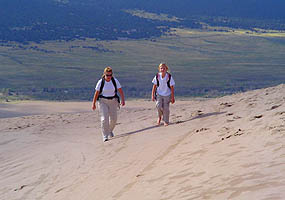 |
| NPS Photo by Scott Hansen | | Hikers ascend one of the highest dunes. In summer months, plan to explore the dunes in morning or evening to avoid hot sand surface temperatures. |
 |
Click on the links above for a variety of information.
Safety Tips
We want your visit to be safe and worry-free. Here are the basics you need to know:
Animals: Poisonous snakes do not exist anywhere in this high elevation park. Rattlesnakes are occasionally seen south of the park boundary, as the elevation gradually decreases. Scorpions, tarantulas, and gila monsters are not found in this high mountain valley. Deer and elk are commonly seen in the park and on park roads. Pronghorn antelope also graze near park roads. Drive slowly, especially at night, to avoid hitting one of these animals.
Keep Wildlife Wild! Never feed or approach wild animals. Deer, squirrels, and chipmunks may appear tame or hungry, but you should never approach too closely - your safety and their health is at risk! Nature provides plentiful food for wild animals, and they need the nutrients provided by wild food to remain healthy. Some wild animals carry diseases which can be transmitted to humans.
Insects: For a few weeks each mid-summer, tiny piñon flies cluster around campers and hikers, attracted to the carbon dioxide exhaled by humans. While often annoying, they do not bite. In wet years mosquitos and biting gnats ("no-see-ums") are common from roughly mid June to early August. Ticks are common in April, May and June in the forest and shrub land surrounding the dunes. There are no ticks in the dunes. Brown recluse and black widow spiders do exist throughout North America's woodlands and grasslands, but both are secretive and rarely encountered. No poisonous insects or animals exist in the dunes themselves.
Lightning: The barren dunes are subject to lightning strikes. Thunderstorms with electrical potential are most common in the summer months. When you see thunderheads forming or hear thunder, leave the dunes and seek shelter in a building or in your vehicle. A direct lightning bolt may carry 100 million volts of electricity. In comparison, household current runs about 110 to 220 volts.
Hot sand: Surface temperature on the dunes may reach 140 degrees Fahrenheit. Heat is generated from the reflecting sun in a world relatively barren of vegetation. Hot sand can blister bare feet - wear shoes when hiking. Take sunscreen, as skin burns easily at this high elevation (8,200). Remember your pet's feet are sensitive to burns, too. Avoid hiking with your pet on the dunes during the hottest parts of the day.
Sand collapse: Digging deep holes anywhere in the sand can be dangerous, thanks to sand's potential to collapse. If you've ever been buried at the beach by "friends", you know how impossible it can be for someone trapped in a collapsed hole to escape without help. Parents, make sure your kids don't dig more than about 18" down, and never dig deep holes or caves into the base of steep dunes.
High elevation: The Visitor Center and Campground areas are about 8200' above sea level. The highest elevation in the park is 13,604'. Some people experience headaches, dehydration, fatigue, sleeplessness, rapid heartbeat, and shortness of breath at this altitude. Drink plenty of liquids, avoid alcohol and caffeine, and move slowly until your body acclimates.
Wind and sand: Remember, the dunes are where they are because of the wind! Wind-blown sand can be painful and dangerous. Plan to hike the dunes in morning or evening hours when it's more likely to be calm and cool, and check the forecast if you are heading into the backcountry. Afternoons, especially in spring, are sometimes windy and can be uncomfortable on the sand.
Water quality: Backcountry hikers should treat any surface water by filtering or boiling.
Pets: Pets must be on a leash and attended at all times. Pets succumb faster to heat than humans; sand is hot and shade is scarce. Never leave a pet in a car on a summer day; temperatures can reach 100+ degrees within minutes. Remember, your pet's feet are as vulnerable to hot sand as yours are.
| 






